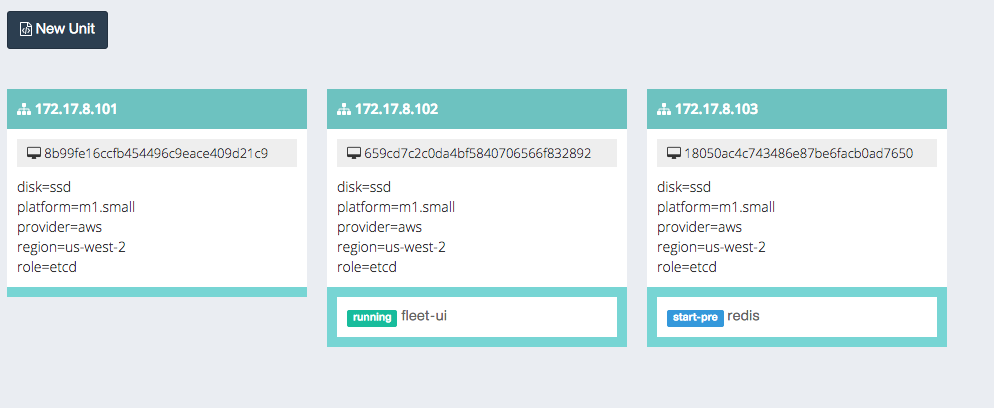Docker Development Env On CoreOS
A docker application/service devevlopment environment on Vagrant/CoreOS with:
- All the goodies come with CoreOS, i.e. Etcd2, Fleet, Flannel, Systemd, Journal, OS auto-updates etc.
- A SkyDNS service.
- A FleetUI service.
- Https support for web applicaitons with a wildcard self-signed certificate
- Fleet units for applications/services:
- private docker registry with https basic-auth
- confd
- nginx
- haproxy
- mysql
- redis
- timer
- flannel
Full lists of apps are under apps directory. There is a working flannel cluster in which docker containers run on their own private network than that of the docker host.
Installation dependencies
- VirtualBox 4.3.10 or greater.
- Vagrant 1.6 or greater.
Or
- VirtualBox 5.0 or greater.
- Vagrant 1.7.4 or greater.
Clone this project
git clone https://github.com/xuwang/coreos-docker-dev.git
cd coreos-docker-dev
Vagrantfile controls the cluster provisioning. The checked out git repo directory is shared as /home/core/share in each node, so you can put persistent data under /home/core/share. You will be asked for your password to enable the NFS sharing from the host.
Cluster configuration
Under nodes-conf directory, you can find different size of cluster configurations and default service port mappings. You can modify json files to change the defaults, and in Vagrant configuration, pick the one you will use. The default is one node cluster. Note you will need a powerful ldaptop in order to run 3 notes cluster-large.json configuration. Memory allocation used by each node can be adjusted in .json file.
NODES_CONF = File.join(MY_PATH, "nodes-conf", "standalone.json")
#NODES_CONF = File.join(MY_PATH, "nodes-conf", "cluster-flannel.json")
#NODES_CONF = File.join(MY_PATH, "nodes-conf", "cluster.json")
#NODES_CONF = File.join(MY_PATH, "nodes-conf", "cluster-large.json")
#NODES_CONF = File.join(MY_PATH, "nodes-conf", "cluster-secure-etcd.json")
Start the cluster
vagrant up
vagrant status
vagrant ssh [<node name>]
Skydns service should be started automatically:
Networking on your machine might cause it not to start automatically. Try to start manually:
sudo systemctl start skydns.service
Private registry should also be started automatically, again use the systemctl command to verity:
systemctl status registry
To save a copy of the registry so it won't try to pull from dockerhub next reboot:
dksave registry
The skydns and reigstry are two systemd units configured in the cluster's cloud-init. Once these two services are ready, you can start other services.
Registry container registers itself as 'registry.docker.local' in skydns.
Start service units
Units are located under share/apps//units directory. In general, you can start a service like so:
cd share/apps/<service>/units
fleetctl start <name>.service
For example, to start mysql server:
cd share/apps/mysql/units
fleetctl start mysql.service
When service is ready, it registers as 'mysql.docker.local' in skydns.
To check status of fleet units:
fleetctl list-units
To tail a service log, for example, mysql:
journalctl -f -u mysql.service
Skydns domain name is cluster.local. To check skydns:
core@n1 ~/share $ els /skydns
/skydns/config
/skydns/local
/skydns/local/docker
/skydns/local/docker/dns
/skydns/local/docker/dns/ns
/skydns/local/docker/dns/ns/xca8538abbd0f48d0a5382b6560294dab
/skydns/local/docker/n1
/skydns/local/docker/registry
/skydns/local/docker/mysql
You should be able to test mysql:
ncat mysql 3306
Start fleet UI
cd share/apps/fleet-ui/units
fleetctl start fleet-ui.service
It can take very long for this service to come up on laptop. This one first pull a builder image and build the fleet-ui image on the fly. To check status:
fleetctl status fleet-ui.service
And when it is ready:
core@n2 ~ $ fleetctl list-units
UNIT MACHINE ACTIVE SUB
fleet-ui.service 659cd7c2.../172.17.8.102 active running
mysql.service 18050ac4.../172.17.8.103 activating start-pre
In this example, the fleet service is running on 172.17.8.102. You can point your browser to 172.17.8.102:3000 to visualize what's running on the cluster:

Clean it up
Exit coreos vm node and:
vagrant destroy
